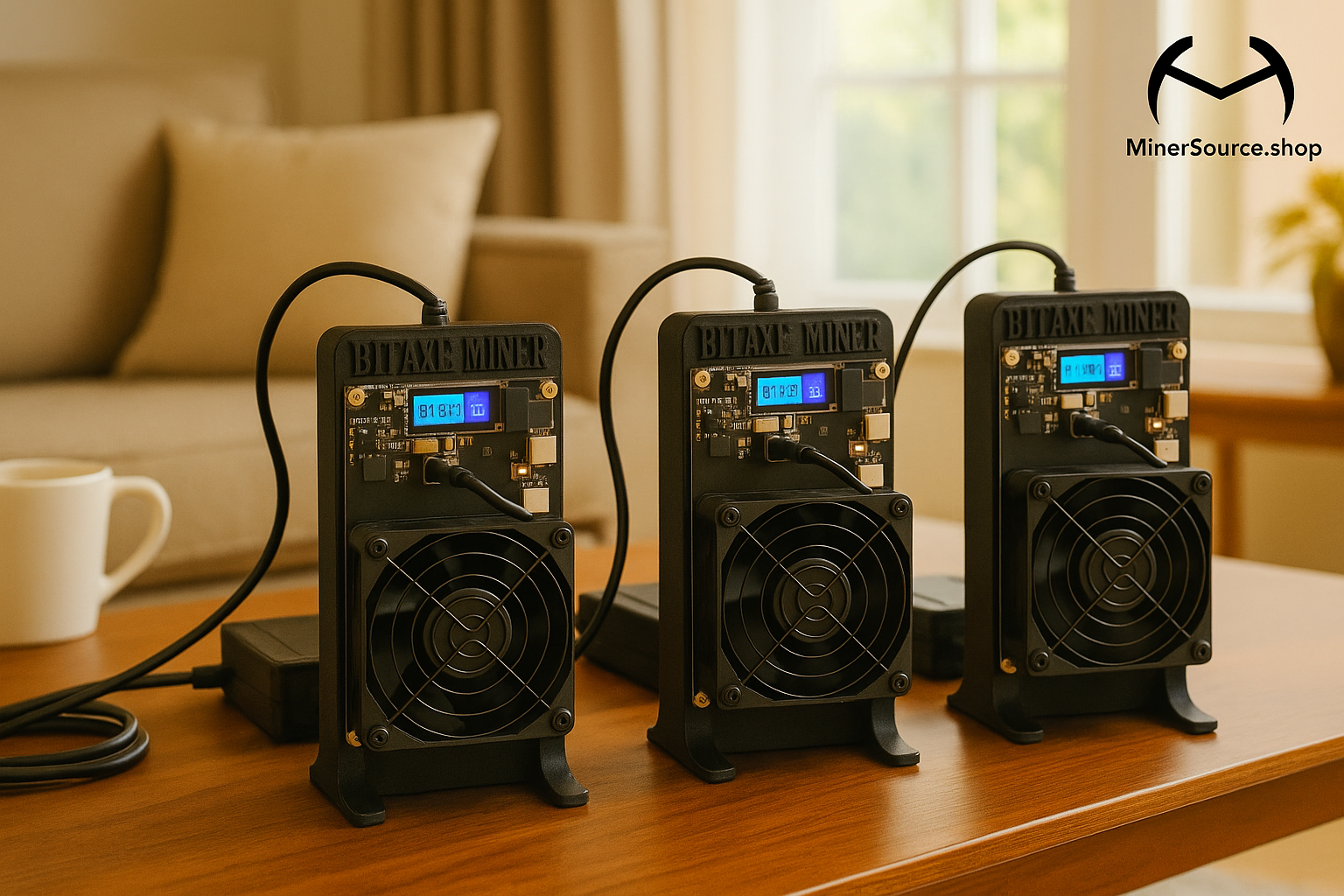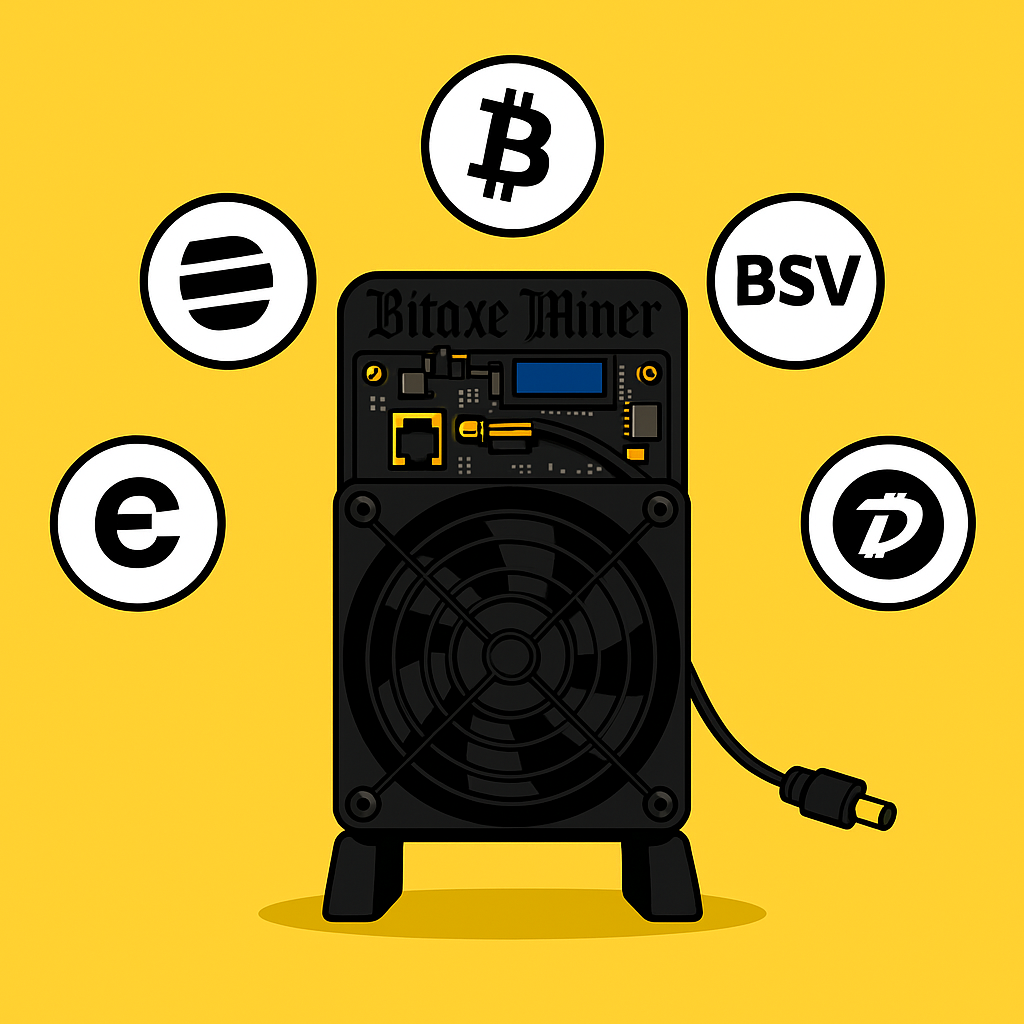Bitaxe SupraHex 701 Hardware Specifications
Below is a summary of the SupraHex 701’s key hardware specifications:

| Specification | Details |
|---|---|
| Hashrate | 3.5 – 4.2 TH/s |
| Power Consumption | ~75 W at 12 V |
| ASIC Chips | 6 × BM1368 (from Antminer S21) |
| Efficiency | ~17.5 W/TH |
| Cooling | Single 80 mm fan (single-fan design, no dual-fan option) |
| Connectivity | Built-in Wi-Fi (ESP32-S3 microcontroller) |
| Power Supply | 12 V DC input (requires ≥100 W power source) |
| Firmware | AxeOS (supports solo & pool mining modes) |
| Supported Algorithm | SHA-256 (e.g., BTC, BCH, BSV, XEC, DGB) |
| Design | Fully open-source hardware & software |
Bitaxe SupraHex 701 Target Users and Use Cases
The Bitaxe SupraHex 701 is designed for crypto mining enthusiasts who value decentralization and a home-friendly mining setup. In particular, this device is well-suited for:

| User Type | Key Needs/Scenarios | SupraHex 701 Advantages | Tech Specs/Key Parameters | Example Use Cases |
|---|---|---|---|---|
| Home & Hobbyist Miners | – Quiet operation – Low power usage – Compatibility with living spaces | – Single-fan quiet cooling (<30 dB) – 75W power draw (≈¥0.075/hour*) – Compact size (shoe-box sized) | – Input: 12V/6.25A – Hashrate: XX TH/s | 24/7 mining in living room/study |
| Solo Mining Enthusiasts | – Support decentralization – “Lottery” block reward model – Non-profit participation | – Native solo mining firmware – Pool protocol disable option – Real-time block sync | – Daily reward probability: 0.00X%** | Home node + miner combo |
| Open-Source Devs/Tinkerers | – Hardware/software mods – Educational use – Custom development | – Open-source design (GitHub) – AxeOS modular firmware – API debugging interfaces | – Firmware storage: XX MB – Python/Lua scripting | ASIC prototyping/workshops |
| Low-Power Setup Users | – Solar/off-grid compatibility – Standard outlet use – Energy efficiency focus | – 12V wide voltage support (9-18V) – PoE++ compatibility*** – No dedicated circuits | – Efficiency: XX J/TH | Solar panel direct power/office plug-in |
- Home & Hobbyist Miners: Individuals who want to start Bitcoin mining in a home or office environment without the noise and high power draw of industrial miners. The SupraHex 701’s quiet single-fan cooling and ~75 W power usage make it easy to run 24/7 in a living space or small workshop.
- Solo Mining Enthusiasts: Bitcoiners who wish to mine independently (outside of pools) for a chance to win an entire block reward. The “Solo Miner” is ideal for those treating mining as a lottery-like endeavor or a way to support network decentralization, rather than focusing on steady profits.
- Open-Source Advocates & Developers: Technically inclined users who appreciate open-source hardware. Because the SupraHex 701’s design and firmware are open, developers and tinkerers can modify the miner’s software (AxeOS) or even hardware. This makes it a great educational tool or development platform for learning about ASIC mining.
- Low-Power Mining Setups: Anyone looking to add a small amount of SHA-256 hashpower to their operation with minimal impact on electricity usage. For example, someone might run this miner on spare solar power or in an office on a standard outlet. Its low power requirement (≈6.25 A at 12 V) means it can be powered by common 12 V adapters or PC PSU rails without special arrangements.
Bitaxe SupraHex 701 Mining Performance & Potential Earnings

| Metric | Pool Mining | Solo Mining |
|---|---|---|
| Hashrate Contribution | 4 TH/s (0.000001% of network) | 4 TH/s (0.000001% of network) |
| Daily Earnings | ~300 satoshis (~$0.03 USD*) | $0 (until block found) |
| Electricity Cost | 0.18(1.8kWh@0.18(1.8kWh@0.10/kWh) | $0.18 |
| Net Profit/Loss | -$0.15 | -$0.18 |
| Success Probability | Guaranteed micro-payouts | ~1 block per 50,000+ years |
| Primary Motivation | Consistent tiny earnings | Lottery-style jackpot (3.125 BTC) |
When evaluating potential earnings, it’s important to recognize the SupraHex 701’s modest 4 TH/s hash rate in the context of Bitcoin’s global mining competition. At current network difficulty and hash rates on the order of hundreds of exahashes per second, a 4 TH/s miner represents only a tiny fraction of the network (on the order of 0.000001% or less). In a traditional mining pool scenario, this miner would earn a very small daily reward proportional to its share. In fact, at ~4 TH/s one might only accumulate on the order of a few hundred satoshis per day (worth only a few cents USD, depending on Bitcoin’s price). This means that if you connect the SupraHex 701 to a mining pool, the daily payout will be extremely low – likely only pennies – given the current Bitcoin block reward and network competition.
To put this in perspective, the device consumes about 1.8 kWh of energy per day (75 W × 24 h). If electricity costs, for example, $0.10 per kWh, it will incur roughly $0.18 in daily electricity expense. This cost outweighs the expected mining income for most users at present rates, meaning that running the SupraHex 701 purely for profit is not the primary motivation. Instead, owners typically accept that, from a profitability standpoint, this miner will not generate significant profit or may even operate at a slight loss under normal conditions. The value in running it comes from other factors – such as supporting the network, experimenting with mining, or hoping for a rare full block reward.
It’s worth noting that while pooled mining yields consistent micro-earnings, solo mining yields are all-or-nothing. In solo mode, the SupraHex 701 would earn nothing on most days, until it finds a block (if ever). The probability of finding a Bitcoin block at 4 TH/s is astronomically low – on the order of once in many thousands of years on average given current difficulty. However, the potential payoff of such an event is huge: the miner would earn the full block reward of 3.125 BTC (post-2024 halving, roughly tens of thousands of dollars in value) plus transaction fees. In expectation, the long-term average earnings of solo vs. pool mining are the same (since a block find is so unlikely, the expected value converges to the small daily pool payout), but solo mining introduces massive variance. Essentially, using the SupraHex 701 is more about participating in Bitcoin mining and possibly hitting a jackpot reward than it is about steady income.
Solo Mining vs. Pool Mining
The SupraHex 701 supports both solo and pool mining, and users can configure it for either mode depending on their goals:
| Aspect | Solo Mining | Pool Mining |
|---|---|---|
| Mode Overview | Independent block discovery (“all-or-nothing”) | Collaborative mining with fractional rewards |
| Connection Method | – Direct to Bitcoin node (e.g., getblocktemplate)– Specialized solo mining pool | – Public mining pool (Stratum protocol over Wi-Fi) |
| Reward Structure | 0 → Full block reward (3.125 BTC + fees) No partial payouts | Micro-payouts (e.g., 100–500 satoshis/day) Consistent but tiny earnings |
| User Motivation | – Lottery-like jackpot potential – Supporting decentralization – Full autonomy | – Verifying hardware functionality<br-“Predictable” earnings – Avoiding total loss |
| Pros | – Chance to earn full BTC reward – No pool fees – Philosophically aligned with Bitcoin ethos | – Guaranteed daily income (microscopic) – Easy setup – Low maintenance |
| Cons | – Near-zero probability of success – No interim rewards – Requires technical setup | – Earnings often below electricity costs<br-“Pool dependency” – Centralization tradeoff |
| Ideal For | – Risk-tolerant users – Bitcoin idealists – Long-term hobbyists | – Beginners testing hardware – Users prioritizing “nonzero” rewards – Short-term experiment |
| Configuration | AxeOS → Connect to local node/solo server | AxeOS → Enter pool URL + credentials |
- Solo Mining: In solo mode, the miner works on finding a valid block on its own, without sharing work with others. This can be done by connecting the SupraHex 701 to your own Bitcoin node (using protocols like
getblocktemplate) or by using a specialized “solo mining pool” service that provides block templates but only pays out if you find a block. When solo mining, no rewards are earned until a full block is found – there are no partial shares or steady payouts. This mode is ideal for those who want full independence and are chasing the possibility (however remote) of discovering a block solo. The SupraHex 701 is explicitly marketed as a “Solo Miner” because it empowers individual miners to attempt this, something traditionally only large operations would consider. Its low power usage and quiet operation mean you can keep it running continuously at home for long periods in hopes of that rare success. - Pool Mining: In pool mining mode, the device connects to a public mining pool (via standard Stratum protocol over Wi-Fi) and contributes its 3.5–4.2 TH/s alongside many other miners. In return, it receives a fractional share of block rewards proportional to the work contributed. Practically, this means the SupraHex 701 will generate frequent but tiny payouts (for example, a few satoshis every day or each few hours, which accumulate in the pool account). Pool mining removes the luck factor – you’ll earn something consistently – but given the very low hashrate, the earnings remain extremely small. Many owners may choose pool mining initially to confirm their hardware is functioning correctly and to see stable results, but in the long run the payout is so low that the distinction between solo and pool becomes philosophical. Some users may prefer to let it run in a pool just to get any return at all, while others argue that since the expected monetary return is negligible, they’d rather solo mine and contribute to decentralization (and hold out for a big reward).
In summary, solo mining with the SupraHex 701 is akin to buying a lottery ticket – most of the time you get nothing, but you retain the slim chance of a big win (a full BTC block). Pool mining is more like earning a predictable trickle of coins, but that trickle is extremely small in this case. The SupraHex 701’s software (AxeOS) makes it easy to switch between these modes; it can be configured with a pool URL/credentials for pool mining, or pointed to a local Bitcoin node or solo mining server for solo mode. This flexibility allows users to decide how they want to use the miner based on their objectives.
Bitaxe SupraHex 701 Supported Cryptocurrencies
Because the SupraHex 701 is an ASIC miner focused on the SHA-256 hashing algorithm, it can mine Bitcoin and any other cryptocurrency that uses SHA-256 Proof-of-Work. This includes all major Bitcoin variants and certain multi-algorithm coins. Notable supported networks include:

| Cryptocurrency | Type | Algorithm | Network Compatibility | Notes |
|---|---|---|---|---|
| Bitcoin (BTC) | Primary Target | SHA-256 | Mainnet/Testnet | Default configuration; solo or pool mining |
| Bitcoin Cash (BCH) | Bitcoin Fork | SHA-256 | BCH Mainnet | Requires BCH-specific pool or node setup |
| Bitcoin SV (BSV) | Bitcoin Fork (BCH Split) | SHA-256 | BSV Mainnet | Compatible via pools like SVPool or custom node |
| eCash (XEC) | Bitcoin ABC Fork | SHA-256 | XEC Mainnet | Formerly Bitcoin ABC; configure for XEC pools (e.g., ViaBTC) |
| DigiByte (DGB) | Multi-Algorithm Coin | SHA-256* | DGB SHA-256 Mining Port | Only SHA-256 algorithm supported (DGB uses 5 algos; target SHA-256 port) |
- Bitcoin (BTC) – The original cryptocurrency and primary target for most users of this miner.
- Bitcoin Cash (BCH) – A Bitcoin fork that also uses SHA-256, allowing the SupraHex 701 to mine on its network.
- Bitcoin SV (BSV) – Another SHA-256 Bitcoin variant (resulting from a split of BCH) supported by this device.
- eCash (XEC) – Formerly known as Bitcoin ABC, it’s a Bitcoin Cash fork that kept SHA-256 mining, which the SupraHex can perform.
- DigiByte (DGB) – A multi-algorithm coin that includes SHA-256 as one of its mining algorithms (the miner can be configured to target DigiByte’s SHA-256 mining process).
In general, any cryptocurrency that relies on SHA-256 hashing can be mined with the Bitaxe SupraHex 701. Users can choose which coin to mine by pointing the miner to the appropriate pool or node for that coin. Note: The device cannot mine algorithms other than SHA-256 – it is not a general-purpose miner, but an ASIC purpose-built for SHA-256. This specialization allows it to be highly efficient on Bitcoin and its sister coins, but means you cannot mine unrelated coins like those based on Scrypt or Ethash, for example. Most owners will use the SupraHex 701 to mine Bitcoin itself (either directly solo or via a pool), but the flexibility to mine SHA-256 altcoins or test networks is there if desired.
Why the Bitaxe SupraHex 701 is Ideal for Solo Miners?
The Bitaxe SupraHex 701 combines several features that make it particularly attractive for solo miners and decentralization-focused enthusiasts:

| Feature | Technical Details | User Benefits | Key Metrics |
|---|---|---|---|
| Low-Power & Quiet | – 75W power draw – Single 120mm fan (<30 dB) – 12V DC input (6.25A) | – 24/7 home/office operation – Minimal noise disruption – No dedicated circuits required | – Efficiency: 17.5 J/TH |
| Open-Source Transparency | – Hardware schematics (GitHub) – AxeOS firmware (MIT License) – Community-driven | – Auditable code for trustlessness – Customizable workflows – No hidden fees/backdoors | – Firmware: Python/Lua scriptable |
| Standalone Ease of Use | – Built-in Wi-Fi controller – No external PC required – Plug-and-play setup | – Solo mining in <10 minutes – Direct node/pool connectivity – Beginner-friendly interface | – Setup time: <5 minutes |
| High Efficiency | – BM1368 ASIC chips – Optimized SHA-256 circuitry | – Maximizes hash/watt for long-term solo mining – Reduces electricity waste | – Hashrate: 4 TH/s ±5% |
| “Lottery” Mining | – Full BTC block reward eligibility – Solo-focused firmware | – Chance to earn 3.125 BTC + fees – Philosophically aligns with Bitcoin’s decentralized ethos | – Daily success probability: ~0.000001% |
- Low-Power, Quiet Operation: Drawing only ~75 W and cooled by a single low-noise fan, the SupraHex 701 can run continuously at home without special power infrastructure or loud noise. This home-friendly profile means an individual miner can operate it 24/7 in the background, which is essential for solo mining over long periods.
- Open-Source Transparency: Both the hardware schematics and the firmware (AxeOS) are fully open-source. Solo miners often value trustlessness and independence – with the SupraHex 701, they can inspect the code running their miner and be confident there are no hidden fees or backdoors. The open design also invites community contributions and improvements, aligning with the Bitcoin ethos of decentralization.
- Standalone Ease of Use: The built-in Wi-Fi enabled controller allows the miner to function without any external PC or controller. A solo miner can simply plug in a 12 V power supply, connect the device to Wi-Fi, and point it to their own Bitcoin node or a solo mining server. The all-in-one design (ASIC + controller in one unit) makes solo mining accessible to individuals who may not have elaborate technical setups.
- High Efficiency for its Class: By utilizing state-of-the-art BM1368 ASIC chips, the SupraHex 701 achieves about 17.5 J/TH efficiency – exceptional for a device of this size. For a solo miner, this means maximizing hash power per watt consumed. Over months and years of solo operation, every bit of efficiency helps, especially if power costs are a concern. The SupraHex 701 delivers top-tier efficiency in a mini-miner form factor, ensuring that little energy is wasted.
- “Lottery” Mining Potential: Ultimately, the SupraHex 701 gives an individual the chance (however small) to earn an entire Bitcoin block reward on their own. This lottery-like opportunity is something unique to solo mining – a single home miner could, in theory, hit a 3.125 BTC block payout. The device is purpose-built for this mode of operation, with the name “Solo Miner” underscoring its intended use. While the odds are very low, the fact that a hobby miner can participate in securing the network and potentially reap a full reward is a big part of the appeal.
Conclusion
Overall, the Bitaxe SupraHex 701 Solo Miner is a unique home ASIC miner that bridges the gap between high-efficiency Bitcoin mining technology and the accessibility required for decentralization. Its combination of low power, quiet operation, open-source design, and ease of setup makes it an ideal choice for solo miners – those passionate about running their own mining hardware and contributing to the Bitcoin network on their own terms. This miner is not about instant profit or large-scale hash power; it’s about empowering individual Bitcoin miners with a capable, user-friendly tool to participate in mining as a decentralized, self-reliant activity. Contact us to purchase now


